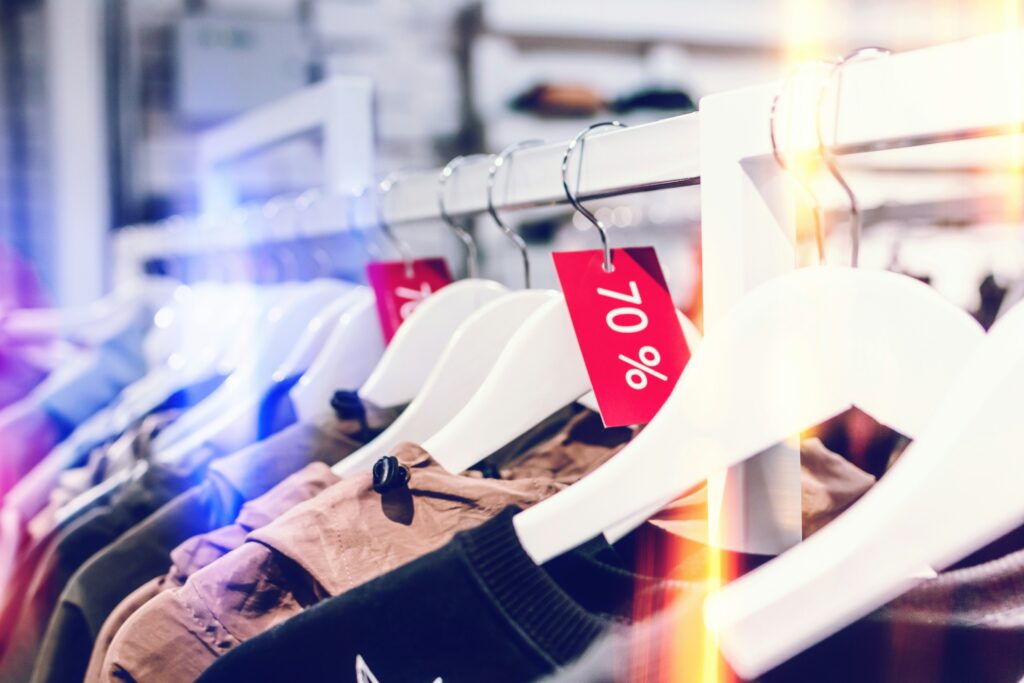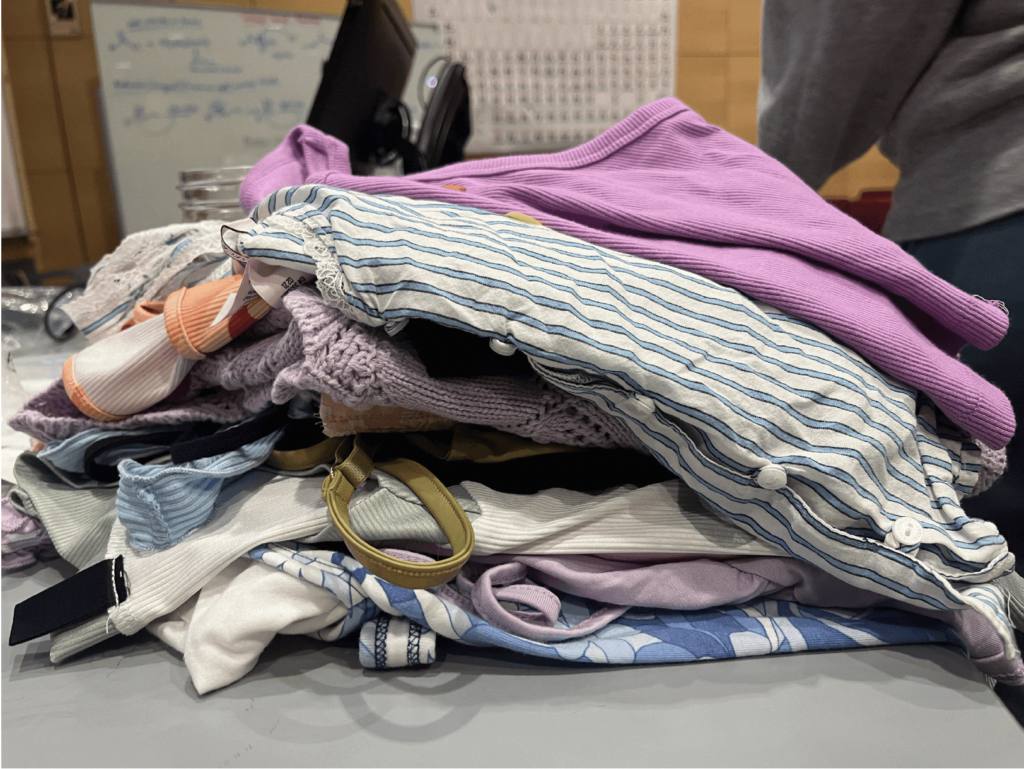
By Emily Sharkis | UConn Journalism
April 7, 2024
Glance around a mall, concert hall, or college campus and chances are you will see at least one piece of fast fashion clothing — often without even knowing it.
According to consulting firm McKinsey and Company, fast fashion is defined as articles of clothing rapidly and cheaply produced, often accompanied by strong manufacturer-to-consumer supply chains and loyal customer bases. The fast fashion market is growing quickly, with Statistica predicting the market value of fast fashion will reach approximately $185 billion by 2027.
An example: One friend recently mentioned dropping $300 on clothes from Shien, a popular online retailer, for an upcoming vacation.
Despite its popularity, the negative effects of fast fashion are a lot more widespread than many initially realize. Alongside Shien, stores like Forever 21, Zara, H&M, Old Navy, and Urban Outfitters all sell fast fashion.
While many deem purchasing fast fashion as morally wrong, many college students continue to buy from these retailers. But why?
1. It’s Absolutely Everywhere — And It’s Cheap
Fast fashion clothing options tend to be cheaper than clothing from sustainable companies, a fact mentioned by 15 of the 18 people recently polled for this story. Fast fashion is not only widespread, it’s often hiding in plain sight.
“Fast fashion is so prevalent we don’t even realize it,” one University of Connecticut student remarked. “Almost every store at the mall is fast fashion no matter the price. Zara for example, is so expensive, but one of the least ethical brands out there. Price doesn’t equal quality, and quality doesn’t equal sustainability.”
This prevalence is furthered by fast fashion’s presence on social media. “I see a lot of people on TikTok doing huge (and often sponsored) fast fashion hauls and it really contributes to a strong sense of overconsumption,” said UConn junior Mia Keazer.
2. It’s Size-Inclusive
“I remember going to the mall with my friends in high school and being so excited to go into Forever 21 because that was the only store that I could actually buy things in,” said UConn Junior Nala Davis.
It’s a frustration this writer shares: many clothing brands simply do not have size inclusive options.
“I’m plus-sized and it’s hard to find anything in my size that’s affordable and is a style that I like. Sadly only [fast fashion] companies check all the boxes,” said Katiely Mercedes, a Junior at Hunter College.
“As a curvy girl, sometimes the sustainable fashion lines do not have my size or are not flattering on me. I know my weight fluctuates and when buying jeans I would rather buy the ones that are less expensive,” said UConn Sophomore Cianna Tangishaka.
3. Greenwashing
Greenwashing is the practice of making a product or activity appear to be less damaging to the environment than it really is. Greenwashing practices can include a lack of public information, reliance on discredited measurement tools, having unregulated “eco-conscious” collections, and more.
According to the non-profit Greenpeace UK, stores such as H&M, Zara, Primark, and more, are guilty of greenwashing. While greenwashing can be damaging, many people are unaware it is even happening.
“I remember seeing a promotional advertisement about H&M creating an environmentally friendly clothing line, and then researching for a class that this was actually totally false (at least back then). Almost any company can claim “clean & sustainable fashion” through plain imagery of green leaves/recycling logos on the tag to imply clean fashion without actually claiming it,” said UConn senior Elizabeth Agarunova.
“I used to work for Uniqlo, and I would notice how many shipments would come in…from third world countries, and the amount of waste within the shipments despite the company’s claims of caring for the environment. Out of curiosity, I searched it up and they’re a greenwashing fast fashion company, and their prices seem to tell people otherwise. I realized price really doesn’t dictate,” Mercedes added.
4. Trends Move So Fast
One of the biggest advantages of fast fashion companies is their wide variety of styles and large number of new designs per day. However, with these seemingly nonstop new
items, trends move so fast, making it almost impossible to keep up. This has only encouraged a culture of consumerism and overconsumption.
“Our society values keeping up with the fashion of today so much that stepping outside of that mindset can feel like social death to an extent,” said UConn Graphic Design student Caroline Strapp.
This issue is especially prevalent in college, where having both a professional and party wardrobe and staying on-trend are the norm.
“I had gotten a whole bunch of going out tops and by the time I tried to wear them people had stopped wearing that style of top,” remembers Buffalo State freshman Allie Cigna.
Some people also mentioned needing quick and quality outfits for concerts, Halloween, and other special occasions.
“I think the way we will see the most change in regards to this topic will be when the culture shifts to value our environment and health more than money and material items. The United States lives and breathes capitalism and the pillars of that belief system directly oppose those who value sustainability and socially conscious initiatives. Until there is a culture shift in values we will continue to see this battle between ethics and greed,” said Strapp.
With these compelling reasons supporting fast fashion, it seems buying fast fashion is inevitable. Still, there are ways to cut down on consumption.

A pile of fast fashion tops sit on top of a desk. The items were donated to Her Campus UConn for the student organization’s thrift shop fundraiser in March 2024. Photo by Emily Sharkis
Go Thrifting
Shopping at thrift stores is a fun and easy alternative to purchasing from fast fashion companies.
According to Capital One Shopping’s 2024 Thrifting Report, “83% of Gen Z consumers have either purchased or are interested in secondhand apparel, 10.7% more than the average for all age groups.”
Re-Wear Old Clothes
Try to end the cycle of endless consumption, what eBay calls “single-season wear,” by mixing and matching to create new outfits or simply keeping and actually wearing the clothing you already own. Amy Bannerman, eBay’s Pre-Loved Style Director, suggests dyeing old clothing and layering different pieces to keep your closet fresh.
While it might be nice to tell people to shop more sustainably, marketers and onlookers must remember the reasons why young people turn to fast fashion. Sustainable fashion’s high price point and non-inclusive sizing just isn’t for everyone — at least not yet.
Top image via Artem Beliaikin on Unsplash
